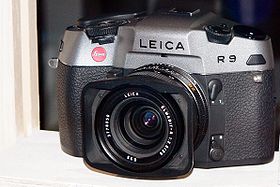Digital Modul R
 |
|
| Overview | |
|---|---|
| Maker | Leica |
| Type | Still image camera |
| Lens | |
| Lens | Leica R bayonet |
| F-numbers | Depends on lens |
| Sensor/Medium | |
| Image sensor type | Film |
| Image sensor size | 24×36 mm |
| Recording medium | 135 film |
| Focusing | |
| Focus | Manual |
| Shutter | |
| Shutter speeds | 1/8000 to 32 s & bulb |
The Leica R8 & R9 are manual focus 35 mm single-lens reflex cameras produced by the German firm Leica as the final models of their R series. Development of the R8 began in 1990: the camera was introduced at the 1996 photokina trade show, and was succeeded by the similar Leica R9 in 2002.
Both can be fitted with the Digital Modul R (DMR) digital back (discontinued in 2007 [1]) and used as a digital camera making them the only 35 mm SLRs to take a user-installable digital back. The R8 was the first R-series camera to have no association with Minolta, being solely a Leica design and showing a clear stylistic change compared to prior bodies.
Industrial designer Manfred Meinzer was chiefly responsible for the R8 design, along with a team of designers largely new to Leica or drawn from outside. The R8 was intended as a clean break from the previous generation of Leica R cameras, which had been developed in cooperation with Minolta. A key design goal was to evoke the Leica M and its smooth top plate; instead of a raised pentaprism as in previous R series cameras, the R8 has sloped "shoulders" that blend almost seamlessly into the pentaprism housing. The shape is strongly asymmetrical, especially in plan view, with a bulged right handgrip and smaller, tapered left-hand side.
Another goal was to improve the ergonomics and to place controls so they could be easily reached and operated without removing the eye from the viewfinder. Although the R8 is capable of fully automated exposure and (with the addition of the integrally-styled motor drive or winder) automated film transport, the location of the shutter speed dial lends itself to manual exposure control, as many Leica customers preferred this. In this it differs strongly from other contemporary SLRs, which were designed primarily for automatic operation. The top control wheels are sunk into the top plate, with knurled edges protruding at the front where they can easily be operated by the photographer's fingertips.
...
Wikipedia
